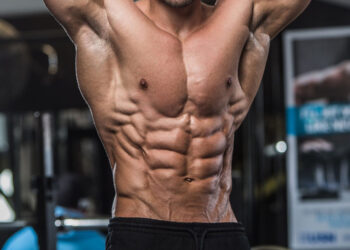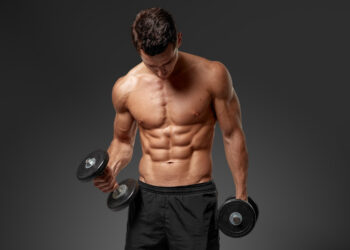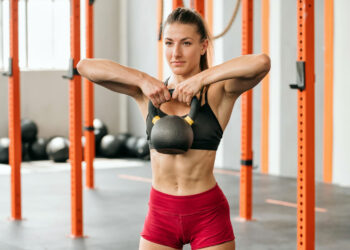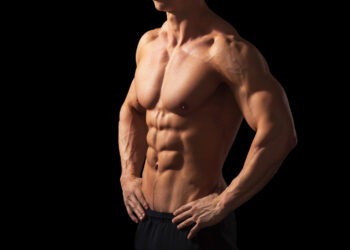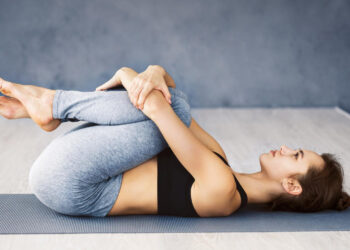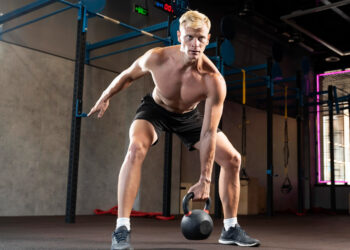While bodyweight ab exercises are convenient, they can quickly become redundant. Often, the only way to increase their difficulty is to perform a higher number of repetitions, leading to inefficient, high-rep sets that can strain the lower back.
With over 35 years of experience as a personal trainer, I consistently incorporate kettlebells—one of the most functional training tools—into my clients’ routines to maximize efficiency and results.
In this article, I reveal the 13 best kettlebell core exercises for building iron-hard abs!
Recent Updates: On May 30, 2024, Fitness Volt’s Senior Editor, Vidur Saini (American Council on Exercise-CPT), revised the list of exercises and updated the article with actionable expert tips to improve the reader experience.
Level Up Your Fitness: Join our 💪 strong community in Fitness Volt Newsletter. Get daily inspiration, expert-backed workouts, nutrition tips, the latest in strength sports, and the support you need to reach your goals. Subscribe for free!
13 Best Kettlebell Core Exercises
Build the midsection of your dreams with the best kettlebell core exercises!
- Single-Arm Kettlebell Farmer’s Walk
- Single-Arm Kettlebell Waiter’s Walk
- Unilateral Kettlebell Front Squat
- Single-Leg Kettlebell Romanian Deadlift
- Single-Arm Kettlebell Overhead Press
- Kettlebell Turkish Get-up
- Kettlebell Windmill
- Kettlebell Dead Bug Pullover
- Kettlebell Double Front Rack Carry
- Kettlebell Unilateral Sit-up
- Kettlebell Single-Arm Swing
- Kettlebell Renegade Row
- Kettlebell Single-Arm Z Press
1. Single-Arm Kettlebell Farmer’s Walk
| Sets & Reps | Equipment Needed | Target Muscles |
| 3 x 20-30m | Kettlebell | Forearms, grip strength, core, traps |
The single-arm kettlebell farmer’s walk is the first of many exercises that train your core indirectly. Your core muscles stabilize your spine and generate internal pressure, a highly functional method for developing exceptional core strength.
Saini recommends actively pulling the kettlebells down toward your hips as you walk. “It creates a more stable shoulder position and ensures optimal balance,” he says.
Steps:
- Hold a kettlebell in one hand with your arm by your side, palm facing your leg. Brace your core and pull your shoulder down and back. Look straight ahead.
- Go for a walk around your training area. Keep your core tight, and your shoulders level throughout.
- Continue until you feel your grip starting to fail.
- Lower the weight to the floor, swap arms, and repeat on the other side.
- Try to cover the same distance.
Coach Tips:
- Use gym chalk or lifting straps for a better grip.
- You can also do this exercise with a dumbbell.
- Increase the stability demands of this exercise by walking zigzags or stepping over obstacles.
| Difficulty | Progression | Regression |
| Beginner | Increase weight or distance, or carry two heavy kettlebells | Stationary kettlebell holds |
2. Single-Arm Kettlebell Waiter’s Walk
| Sets & Reps | Equipment Needed | Target Muscles |
| 3 x 20-30m | Kettlebell | Shoulders, core, forearm, triceps |
This exercise involves carrying your kettlebell overhead at arm’s length. As such, it’s similar to the farmer’s walk but involves less grip strength. However, the longer lever and high center of gravity mean this exercise is considerably more demanding than the farmer’s walk.
“Imagine you’re trying to push the kettlebell through the ceiling,” cues Saini. The upward tension helps stabilize the shoulder and boost core engagement.
Steps:
- Press and hold a kettlebell above your head. Use a neutral grip so that your palm is facing inward.
- Pull your shoulder down and back, and brace your abs.
- Go for a walk around your training area. Keep your core tight and your arm vertical throughout.
- Lower the weight to the floor, swap arms, and repeat on the other side.
Coach Tips:
- Grip the kettlebell tightly to increase shoulder and wrist stability.
- Walk zigzags or step over obstacles.
| Difficulty | Progression | Regression |
| Intermediate | Increase weight or distance, or perform a double kettlebell waiter’s walk | Hold the kettlebell in the front rack position or perform a farmer’s walk |
3. Unilateral Kettlebell Front Squat
| Sets & Reps | Equipment Needed | Target Muscles |
| 3 x 8-12 | Kettlebell | Quadriceps, glutes, hamstrings, core |
All types of squats involve at least some core engagement. However, the single-arm kettlebell front squat is probably one of the best ways to train your core and legs simultaneously. The offset load means you must brace your core hard to keep your torso perfectly vertical.
Saini suggests holding your non-working arm to the side for better balance and stability. Alternatively, you can drive your inactive elbow toward the ceiling as you descend.
Steps:
- Rack and hold a kettlebell on one shoulder. Brace your abs and lift your chest. Then, step out into a shoulder-width stance, toes turned slightly outward.
- Keeping your hips and shoulders level, bend your legs and squat down until your thighs are roughly parallel to the floor.
- Stand back up and repeat.
- Do your next set with the kettlebell on the opposite side.
Coach Tips:
- Adjust your squat depth to reflect your knee health and general mobility.
- Raise your heels on blocks if you want to squat deeper.
| Difficulty | Progression | Regression |
| Moderate | Increase weight | Goblet squat or bodyweight squat |
4. Single-Leg Kettlebell Romanian Deadlift
| Sets & Reps | Equipment Needed | Target Muscles |
| 3 x 8-12 | Kettlebell | Hamstrings, glutes, erector spinae (lower back), core |
The single-leg kettlebell Romanian deadlift is a posterior chain and anti-rotation core exercise. Rotation and anti-rotation are two of the most important but underutilized core movements. This is also one of the best exercises for building a killer butt!
“Beginners must hinge at the hips first and then flex the knees,” says Saini. Breaking the steps down can help improve performance.
Steps:
- Stand with your feet together and your kettlebell in your left hand, arm by your side. Bend your legs slightly.
- Shift your weight over onto your right foot.
- Hinge forward from your hips and lean over, lowering the kettlebell down the front of your leg. Extend your left leg behind you as a counterbalance.
- Stand back up and repeat.
- Swap arms and legs and repeat. Do the same number of reps on the other side.
Coach Tips:
- You can also do this exercise while holding the kettlebell on the same side as the foot you’re balancing on.
- Stand next to a wall or post and use it for balance if required.
| Difficulty | Progression | Regression |
| Moderate | Perform with a barbell | Double-leg RDL |
5. Single-Arm Kettlebell Overhead Press
| Sets & Reps | Equipment Needed | Target Muscles |
| 3 x 8-12 | Kettlebell | Shoulders, triceps, core |
Overhead presses might seem like an odd way to train your core, but doing this exercise unilaterally means your midsection will have to work very hard to keep your torso stationary and upright. You’ll also get a great deltoid and triceps workout from this exercise.
Saini advises retracting and depressing the shoulder blades before initiating the press for a more stable press. It also reduces shoulder impingement risk.
Steps:
- Raise and hold your kettlebell to shoulder height so that it rests against the back of your forearm. Tuck your upper arm into your side.
- Stand with your feet between shoulder and hip-width apart, knees slightly bent for balance. Keep your shoulders and hips level.
- Without using your legs for assistance, press the kettlebell up and overhead to arm’s length.
- Bend your arm, lower the weight back down, and repeat.
- Swap arms and do the same number of reps on the opposite side.
Coach Tips:
- Perform this exercise in front of a mirror to ensure your shoulders and hips remain level.
- Do this exercise with a staggered stance if you find it hard to maintain your balance.
| Difficulty | Progression | Regression |
| Intermediate | Double kettlebell overhead press | Half-kneeling overhead press or strict press |
6. Kettlebell Turkish Get-up
| Sets & Reps | Equipment Needed | Target Muscles |
| 3 x 3-5 per side | Kettlebell | Core, quadriceps, hamstrings, gluteus maximus, deltoids, triceps, forearms |
It’s hard to think of any exercise with a weirder name than Turkish get-ups. Nonetheless, the exact roots of this exercise are unknown. It’s rumored to have been used by traditional Turkish wrestlers back in the day.
This is an excellent but challenging kettlebell core exercise that’s also great for hip mobility and shoulder stability.
Steps:
- Lay on the floor with your legs straight and your right arm extended while holding a kettlebell.
- Bend your right leg, keeping your left leg extended out on the floor in front of you. Your left arm should be slightly extended beside you for support.
- Pushing through your right heel, roll onto your left hip. Keep your arm straight.
- Push your hips up through your right leg, and then slide your left leg behind you. This will bring you to a half-kneeling position.
- Lunge forward into a standing position.
- Reverse the processes to return to your starting position.
- Repeat for the desired number of repetitions and then switch sides.
- Do the same number of reps with both arms.
Coach Tips:
- Start with a light kettlebell — this exercise is harder than it looks.
- Look at your kettlebell throughout this exercise.
- If full get-ups are too demanding, try the half get-up like this:
| Difficulty | Progression | Regression |
| Advanced | Use a heavier kettlebell | Half-get-up or sit-up to half-kneeling |
7. Kettlebell Windmill
| Sets & Reps | Equipment Needed | Target Muscles |
| 3 x 8-12 | Kettlebell | Obliques, shoulders, hamstrings, core |
The kettlebell windmill is a cross between a side bend, waiter’s walk, and single-arm overhead press. It’s an excellent core exercise that improves upper and lower body mobility and stability. But be warned: the windmill is much harder than it looks, so start light and focus on building your technique before you add weight.
“Push your hips away from the kettlebell as you lower yourself,” says Saini. You will also experience a deeper stretch in your hamstrings and increase the challenge to your obliques.
Steps:
- Hold your kettlebell in your left hand above your head, arm straight. Brace your core.
- Position your feet, so they’re slightly wider than shoulder-width apart, toes turned out to around 45 degrees.
- Keeping your arm vertical, hinge at the hips, and lean down toward your left foot with your right hand. Shift your hips to the right as you descend.
- Touch your foot, then return to the starting position, all the while keeping your kettlebell over your head.
- Repeat for the desired number of reps, and then switch hands.
Coach Tips:
- Adjust your range of motion according to your mobility and flexibility. For example, you don’t have to touch your foot and can stop at your knee if you wish.
- Look up at your kettlebell as you lean sideways.
- Focus on hinging from the hips, and do not bend the knees during the movement.
| Difficulty | Progression | Regression |
| Advanced | Increase weight | Decrease weight, half-kneeling windmill, or standing windmill without the kettlebell |
8. Kettlebell Dead Bug Pullover
| Sets & Reps | Equipment Needed | Target Muscles |
| 3 x 10-15 | Kettlebell | Core, lats, deltoids, triceps |
This exercise is so-called because, when you do it, you look a little like a dying fly lying on its back. Macabre names aside, this is an excellent core exercise that emphasizes your rectus and transverse abdominis muscles.
Folks looking for an additional challenge can perform this exercise while holding a kettlebell in each hand, suggests Saini.
Steps:
- Lie on your back with your legs bent to 90 degrees. Press and hold a kettlebell over your chest. Brace your core and press your lower back into the floor.
- Simultaneously extend one leg and lower your kettlebell toward the floor behind your head. Keep your lower back pressed into the floor.
- Return to the starting position, swap legs, and repeat.
- Keep your core braced throughout.
Coach Tips:
- You can also keep your legs stationary like this:
| Difficulty | Progression | Regression |
| Beginner | Perform with a resistance band or cable machine | Dead bug without the pullover |
9. Kettlebell Double Front Rack Carry
| Sets & Reps | Equipment Needed | Target Muscles |
| 3 x 20-30m | 2 Kettlebells | Core, traps |
This is one of those exercises that doesn’t look like much until you try it. Bracing your core, carrying two kettlebells, and walking will fire up your abs and teach you to maintain total body tension. Double front rack carries are a fantastic full-body conditioning exercise.
“Engage your lats and squeeze your shoulder blades together for a stable rack position,” cues Saini.
Steps:
- Rack and hold two kettlebells in front of your shoulders.
- Lift your chest, pull your elbows into your ribs, and brace your core.
- Maintaining tension in your upper body and core, go for a walk around your training area.
- Continue until you feel out of breath or can no longer keep the kettlebells in the front rack position.
- Rest a moment and repeat.
Coach Tips:
- This is a relatively stable exercise, so don’t be afraid to go heavy.
| Difficulty | Progression | Regression |
| Intermediate | Increase weight or distance | Decrease weight, single rack carry, or farmer’s walk |
10. Kettlebell Unilateral Sit-up
| Sets & Reps | Equipment Needed | Target Muscles |
| 3 x 10-15 | Kettlebell | Obliques, rectus abdominis |
Besides the abs, this challenging abs exercise is good for building stable, more mobile shoulders. Unlike many kettlebell core exercises, this move is relatively straightforward but still delivers a challenging abs workout.
Saini suggests thinking about “scooping” your lower abdomen upwards towards your ribcage instead of focusing on crunching your upper body.
Steps:
- Lie on the floor with your legs straight. Hold one kettlebell over your chest, arm straight.
- Brace your abs, contract your quads, and squeeze the kettlebell handle to stabilize the weight.
- Without bending your legs, use your abs and sit up straight. Simultaneously extend your kettlebell over your head, arm straight.
- Lean back and return to the starting position.
- That’s one rep.
- Do the same number of reps with both arms.
Coach Tips:
- Do not anchor your feet, as doing so puts more stress on your lower back and less on your abs.
- You can do kettlebell unilateral sit-ups with your legs bent and feet on the floor.
- You can also do this exercise with two kettlebells, like this:
| Difficulty | Progression | Regression |
| Intermediate | Increase weight or perform a Russian twist | Bodyweight crunches |
11. Kettlebell Single-Arm Swing
| Sets & Reps | Equipment Needed | Target Muscles |
| 3 x 10-15 | Kettlebell | Posterior chain (glutes, hamstrings), core |
If you’ve ever done kettlebell swings before, you already know what an effective posterior chain exercise they are. However, done with one arm, the swing is also a potent core exercise. Using one arm means you’ll have to work extra hard to stop your hips and shoulders from twisting, making this a very functional anti-rotation movement.
Steps:
- Hold a kettlebell in one hand.
- Stand with your feet about shoulder-width apart. Bend your knees slightly, brace your core, and pull your shoulders back and down.
- Hinging from the hips, push your butt back and lean forward to lower the weight between your knees.
- Drive your hips forward and use this momentum to swing the weight forward and up to around shoulder height.
- Keep your arm straight, and core braced throughout.
- Lower the weight and repeat.
- Do the same number of reps on both sides.
Coach Tips:
- Use chalk or wipe your hands on a towel to prevent the kettlebell from slipping from your grasp.
- While you can swing the weight above your head, you’ll probably be more comfortable if you only swing the kettlebell up to eye height.
- You can also do this exercise with an alternating arm action, like this:
| Difficulty | Progression | Regression |
| Moderate | Use a heavier kettlebell | Conventional kettlebell swing |
12. Kettlebell Renegade Row
| Sets & Reps | Equipment Needed | Target Muscles |
| 3 x 8-12 | Kettlebells | Back, core, biceps |
There aren’t many core exercises that are more functional or challenging than kettlebell renegade rows. So, while you will need two kettlebells for this exercise, you will be rewarded with an incredible core workout.
Saini recommends focusing on driving your elbows toward the ceiling instead of pulling with the biceps. This movement better engages the lats.
Steps:
- Place your kettlebells on the floor so the handles are parallel and the weights are about shoulder-width apart.
- Bend down, grab the handles, and walk your feet out and back into the push-up position.
- Brace your abs and pull your shoulders down and back.
- Keeping one arm and your body straight, bend the other elbow and row the weight up and into the side of your abdomen.
- Put the kettlebell back on the floor and then repeat the movement with your other arm.
- Continue alternating arms for the duration of your set.
Coach Tips:
- Alternate renegade rows with deficit push-ups for a complete upper-body and core workout in minutes:
| Difficulty | Progression | Regression |
| Intermediate | Elevate feet or perform push-ups between rows | Perform on knees |
13. Kettlebell Single-Arm Z Press
| Sets & Reps | Equipment Needed | Target Muscles |
| 3 x 8-12 | Kettlebell | Shoulders, triceps, core |
The Z press is named after legendary Lithuanian strongman Žydrūnas Savickas. Known for his immense overhead oppressing strength, this is one of “Big Z’s” favorite pressing exercises. While it’s typically done with a barbell, the single-arm kettlebell Z press is much more core-centric.
Level Up Your Fitness: Join our 💪 strong community in Fitness Volt Newsletter. Get daily inspiration, expert-backed workouts, nutrition tips, the latest in strength sports, and the support you need to reach your goals. Subscribe for free!
“Make sure you have a solid grip on the kettlebell before initiating the press,” urges Saini. A stable base is key to performing this exercise successfully.
Steps:
- Sit on the floor with your legs extended out straight in front of you. Your torso should be perfectly upright. Brace your core.
- Hold a kettlebell in one hand next to your shoulder. Do not lean to the side; instead, use your core to keep your spine perfectly upright.
- Press the weight up and overhead to arm’s length.
- Lower the kettlebell back to your shoulder and repeat.
- Rest a moment, swap sides, and do the same number of reps with your opposite arm.
Coach Tips:
- Sit on a low step or a couple of stacked bumper plates to make it easier to keep your legs straight.
- You can also do this exercise with a single dumbbell.
- Try sitting with your feet astride instead of together. A wider stance is more stable and makes the exercise a little easier to perform, so you may be able to use a heavier load.
| Difficulty | Progression | Regression |
| Hard | Use a barbell | Half-kneeling Z press |
Core Anatomy 101
So, now we have revealed the 13 best kettlebell core exercises, let’s take a moment to discuss the muscles that make up your marvelous midsection.
The main muscles of the core are:
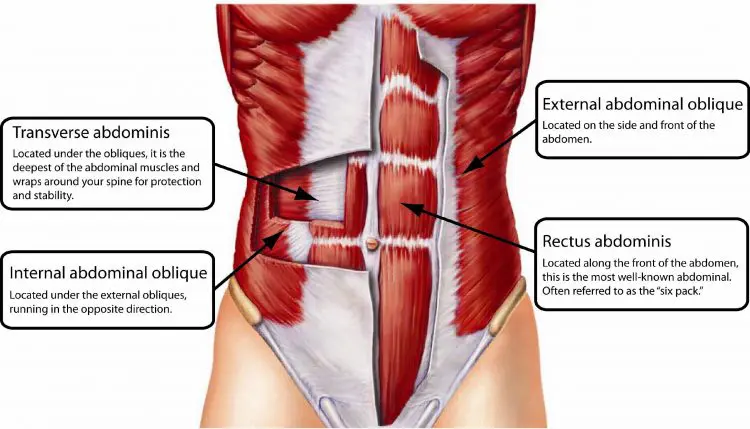
Rectus abdominis
While the rectus abdominis is the most overused and overemphasized core muscle, it’s still very important. The rectus abdominis is located on the front of your stomach. It’s a long, flat muscle separated by lines of ligamentous tissue, which gives it that famous six-pack appearance.
The functions of the rectus abdominis are flexion and lateral flexion of the spine and compression of the abdominal contents.
Obliques
The oblique or waist muscles are located to the side of the rectus abdominis. There are two groups of obliques — internal and external. They work together to rotate and laterally flex your spine.
Erector spinae and multifidus
Erector spinae is the collective name for the three muscles of your lower back — iliocostalis, longissimus, and spinalis. Their primary function is the extension of your spine. However, working with the rectus abdominis and obliques, they also play a significant role in lateral flexion.
Multifidus is another lower back muscle. It works with the erector spinae to extend your spine and forms the back of your abdominal cylinder.
Hip flexors
The hip flexors do exactly what their name implies — they flex your hips. The hip flexor muscles are the liliaceous, psoas major, and rectus femoris, which is one of the quadriceps. While the hip flexors are not abdominal muscles, they can be counted as core muscles as they almost always work alongside the abs.
Transverse abdominis
Usually known as the TVA for short, this muscle encircles your abdomen like a muscular weightlifting belt. When it contracts, the TVA pulls inward to generate intra-abdominal pressure which supports and stabilizes your spine from within.
Bracing your abs, a standard instruction during strength training, increases IAP, keeping your spine rigid and protected from injury.
Diaphragm
The diaphragm is your primary breathing muscle. It’s located at the top of your abdominal cavity and works with your TVA to increase intra-abdominal pressure. The diaphragm is basically the top of your abdominal cylinder.
Timing your breath to your workout helps ensure that IAP is highest when you need it the most, i.e., inhaling as you lift a heavy weight and exhaling as you lower it.
Pelvic floor
Where the diaphragm is the top of your abdominal cylinder, the pelvic floor is the base. Working with the diaphragm, it contracts inward to increase IAP.
3 Kettlebell Core Workouts to Try
Here are THREE kettlebell-only core workouts to try!
Workout 1
| # | Exercise | Sets | Reps | Recovery |
| 1 | Single-arm kettlebell farmer’s walk | 3 | 15-20 yds | 60 seconds |
| 2 | Kettlebell side-bend | 3 | 12-15 per side | 60 seconds |
| 3 | Kettlebell Turkish get-up | 3 | 4-6 per arm | 60 seconds |
| 4 | Kettlebell dead bug pullover | 3 | 12-15 | 60 seconds |
Workout 2
| # | Exercise | Sets | Reps | Recovery |
| 1 | Kettlebell single-arm Z press | 4 | 6-10 per arm | 90 seconds |
| 2 | Kettlebell double front rack carry | 3 | 15-20 yds | 60 seconds |
| 3 | Kettlebell windmill | 2 | 6-10 per side | 90 seconds |
| 4 | Kettlebell renegade row | 1 | AMRAP | N/A |
AMRAP = As Many Reps as Possible.
Workout 3
| # | Exercise | Sets | Reps | Recovery |
| 1 | Single-arm kettlebell waiter’s walk | 2 | 15-20 yds | 60 seconds |
| 2 | Kettlebell deck squat | 2 | 6-10 | 90 seconds |
| 3 | Kettlebell single-arm swing | 2 | 15-20 per arm | 60 seconds |
| 4 | Kettlebell unilateral sit-up | 2 | 6-10 | 90 seconds |
FAQs
1. Will kettlebell core exercises give me six-pack abs?
While these exercises can help develop your core muscles, you won’t get a six-pack unless your body fat percentage is enough for your abs to be visible. Unfortunately, training your abs won’t “spot reduce” fat from your stomach, and the only way to get leaner is to eat less and exercise more.
So, while these kettlebell exercises can contribute toward getting a six-pack, they’re just one of the things you need to do to achieve your goal of washboard-abs.
2. Can I do these exercises with a dumbbell?
You certainly can! Ultimately, your muscles can’t tell if you are holding a kettlebell, dumbbell, or water jug, so use whatever weights you have available. That said, kettlebells are very comfortable to grip. Their low center of gravity makes them a little easier to handle than the same weight dumbbell.
3. Aren’t high reps best for core training?
Not necessarily. The point of any exercise is to fatigue the target muscles. Doing high reps just means this takes a long time. So, for example, if you do 50 reps, and only the last ten are challenging, you’ve essentially “wasted” 40 reps reaching the point where your muscles begin to feel tired. Those easy reps won’t have much of an effect on your abs.
In contrast, if you chose a harder exercise and only do 15 reps, you’ll fatigue your muscles much faster, saving a whole lot of time.
Lower reps are also better for building strength.
While there is nothing inherently wrong with high-rep core training, lower reps make better use of your time and develop more strength. So do a mixture of low and high-rep core training to make your workouts more varied and interesting.
4. How often should I train my core?
Your core is just another muscle group, so all you need is 2-3 workouts per week to fully develop it. Daily core training is a bad idea, as your muscles only recover and grow when you rest.
Also, remember that your core is involved in almost every type of training you perform. As such, you may not need many workouts per week to build your core. Finally, take care not to fatigue your core before something like a big back or leg workout, as you could increase your risk of injury.
5. Some of these exercises hurt my back — what should I do?
Exercises like windmills, unilateral sit-ups, and side bends are notoriously hard on the lower back. They involve unusual movements and a large range of motion. If you spend most of your day sitting at a computer, these exercises will probably come as a shock to your system!
So, if any of these exercises cause back pain, you should skip them and choose less challenging exercises. In most cases, static bracing exercises such as the farmer’s walk, Z press, and front rack carry are easier to tolerate than the more dynamic movements.
That said, you can develop your tolerance to these more challenging exercises by doing them with light weights and gradually increasing your range of motion over several weeks.
Closing Thoughts
Something magical happens to your core when you start training it with weights. Like your biceps or quads, the muscles will start getting stronger and more defined and feel firmer, too.
Kettlebells are one of the best ways to overload your abs. However, most kettlebell core exercises also involve the rest of your body, making them the epitome of functional training.
So, whether you want a six-pack or to improve your athletic performance, kettlebell core exercises will help.


